Pentium MMX 233MHz

Last CPU from Intel intended for desktop market for Socket 7 format. Still popular on eBay and the like, but you could also buy this one new - years after it's release.
Possibly kept in production for industrial purposes. AMD's K6-2 series became popular for notebooks later on and desktop market switched to either the AMD K6-2 or Pentium 2.
During 1997 Intel introduced a new package for their chips - the PPGA package which was not made of ceramic, but was a PCB with pins and a heat spreader on its top to protect the chip. Unlike the Pentium MMX CPGA which was less common, most MMX had this chip package and Intel kept on using it until the 533MHz + Celeron and Pentium III coppermine chips with their FCPGA package that arrived three years later.
This particular piece was produced in April 1997.



